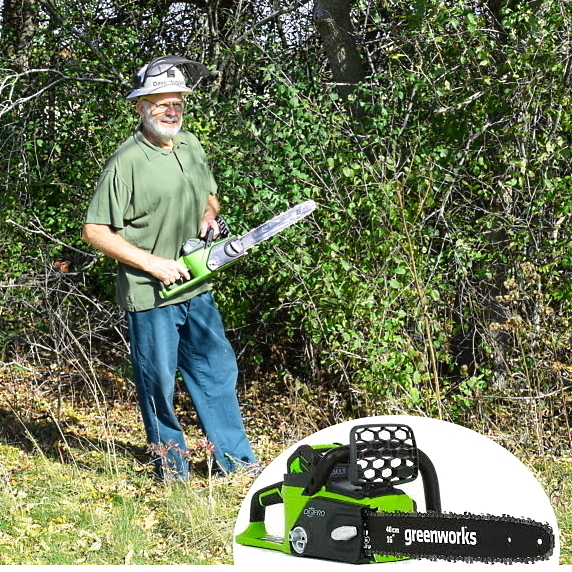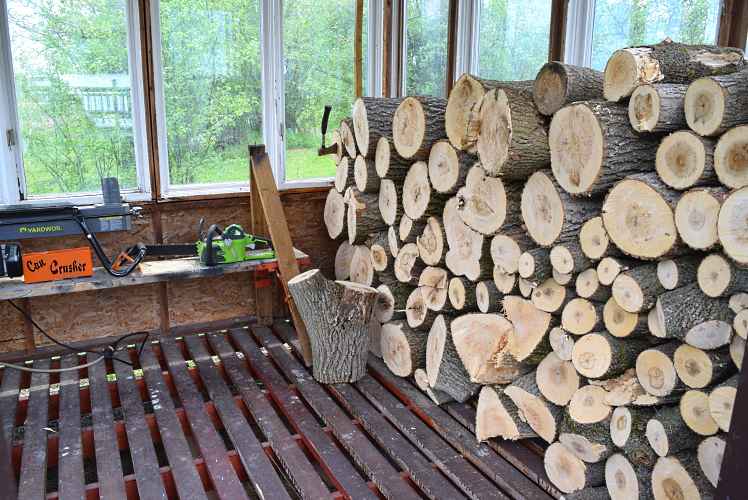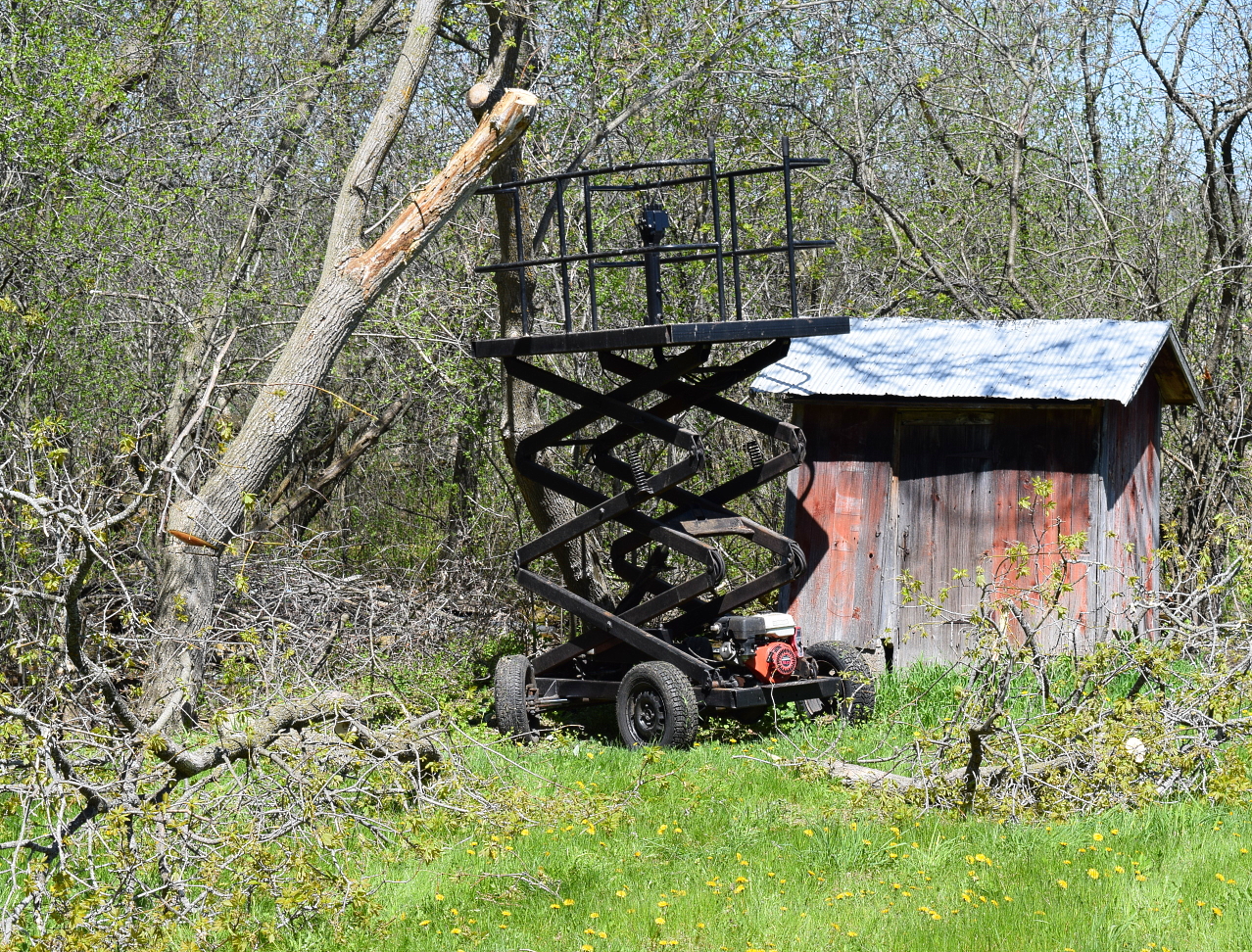
POWERFUL - How big should the engine be?
If you're building your own sawmill you may wish to use an engine that you already have. Mr. Sawmill is designed to use horizontal shaft engines from 8hp to 16hp but I found that the 13hp gives the greatest economy to power ratio. (Not available when I built my first mills, the 15hp - 16hp models would be a good choice today.) The 8hp was slow and unsuitable for the larger logs. When the 16hp models first came out, they cut a bit faster than the 13hp but used more fuel and cost a lot more. Larger than that is even more impractical on this mill because you must lift up that extra weight with a hand crank and the cost of the motor is many times more. A bigger motor may require two drive belts and Mr. Sawmill only uses one, as it also drives the bandwheel. Most readily available and affordable drive belts are not rated for a higher horsepower. Determining a belt’s HP rating can be complex as it's affected by speed, pulley sizes, belt length, wrap angle, tension and other factors. Also, the carriage would also have to be redesigned to accommodate a larger motor. Remember, as the power increases so does weight, fuel consumption and lack of a manual start.
In a *one man contest, Mr. Sawmill cut the same amount of wood in less time than a 24hp hydraulic $20,000 mill, and I used 3 litres of fuel to their 10 litres. That was possible because their hydraulics took some of their horsepower and although they went through the log a bit faster, I returned my (lighter) carriage faster. I also moved my powerhead up and down more quickly (and accurately) and clamped and unclamped the logs faster. (I could have handled a larger log than theirs too.)
Cutting through a log a little bit faster takes quite a bit more power and for each cut, the carriage must be returned to start the next cut. Therefore the speed of the return can be as important as the speed of the cut.
Why Own A Portable Sawmill?
These machines are the most environmentally friendly way to turn trees into lumber. If you own a woodlot you can selectively thin your forest by spot milling, cutting out overcrowded, diseased or dying trees (which helps the others) then move on to the next area.
You don't have to build expensive, destructive roads or use large diesel tractors and skidders to drag logs out to be loaded onto diesel trucks and hauled to stationary mills.
Sometimes old, dying, fallen from storms, or trees that have become a hazard, can be turned into valuable lumber. If the tree is large enough, the trunk can be sawn into lumber, the larger branches cut into firewood and the smaller ones for kindling or "chipped" into mulch.
Lumber created by this method would replace the lumber that you'd normally buy at the lumber store.
The ultimate Personal Sawmill would have a suitably matched electric motor powered by lithium batteries. It could have a removable/exchangable (20-50lb) battery pack which could be charged at any outlet and/or the sawmill's umbrella could be covered with flexible solar cells and/or plugged into a separate portable, array.
What are the Best Features in a Sawmill?
Like most people just learning and not being familiar with a machine we only ask questions about what we can relate to and think important. That usually translates into: How Big, How Fast, How Powerful should it be? So we'll begin with those three questions, although as you learn more, you'll realize that they are not quite as important as they may first seem. (like many things)
- Late October with my Greenworks chainsaw, about to trim some dead branches in my bush, for kindling. This is a 40v Lithium Ion battery powered chainsaw which does all the cutting I need between charges. It will easily handle a 12" branch or tree. There is no buying and then mixing of oil and gasoline, no loud gasoline engine sound, no smoke, no pollution and no pulling on a cord to start. You just push a button. I've even tried it indoors. You don't even need hearing protection as it's quieter than a kitchen blender. As battery technology improves, hopefully all yard machines, including lawn (and even larger) tractors, will be battery electric. Greenworks also makes 60v and 80v saws for even more power and capacity and many other manufacturers make electric yard machines as well. (more pics below)
Zak and Jessie, YouTubers from Now You Know have created this 38 minute comprehensive video called, "A Breath of Fresh Air".
"We only see what we recognize"
"We only hear what we understand" Goethe
BIG - What is the best bed length and width?
The best size portable sawmill to use is the smallest one, and therefore the cheapest to build. On manual mills you must reach over the bed to adjust stops, rotate and clamp the log, etc.. The narrower the bed, the easier this is to do.
The same rule applies to length. The shorter - the lighter, the cheaper to build, the easier to move about the yard or to transport with less bottoming on rough terrain and to park, store or cover. And cutting shorter logs is also easier and less wasteful. A shorter (lighter) log is easier to transport, load and rotate on the mill. A longer log typically has more chance of a curve and there is a greater difference between the top and the butt end, so more wood must be cut off to get that straight beam (cant) in the middle.
So the best size sawmill would be about 16 inches wide and 8 feet long. Right away, you can see a problem with this. What if I have a wider log or need longer boards?
This type of problem is constantly faced by designers and engineers. You want the biggest, fastest and strongest to take up the smallest space, use less fuel and be lightweight and inexpensive. (the most Bang for the least Buck)
My Sawmill has been designed with this in mind. For its weight and size it can cut a wider and longer log than other similar mills. The carriage will handle a 30" wide log and the 18 foot bed frame with its top track extensions will allow an 18 foot log to be cut. Of course you could make the bed even longer, up to 24 feet*, but then you would need a different bed truss design or use 2X6 box tubing. This will add to the cost, weight and cumbersomeness of course.
Another way is to build a detachable bed extension for those rare times when a longer log is required. Keep in mind that the lumber for most building projects (including 30+ foot trusses) needs to be no longer than 12 feet.
* Box Tubing (H.S.S. for Hollow Structural Steel) is usually shipped in 24 foot lengths. Angle Iron, Flat and Round Bar typically come in 20 foot lengths.
FAST - How many board feet per hour?
A board foot is the amount of wood in a piece that is 1 inch thick and 12 inches square. If it's 2 inches thick it would be 6X12 inches, and so on.
Because it's important in industry, "board feet per hour" is mentioned by some portable sawmill manufacturers. But regarding a small portable sawmill for personal use, it's ambiguous. How much wood you can cut depends on many factors including the type of wood you are cutting and whether you're working alone or how many are helping you load the logs and removing and stacking the lumber and your physical condition, how many breaks do you need every hour, etc..
If they are referring to how much wood the sawmill itself can cut, then the logs must be supplied and the lumber removed instantly. To measure this you would load a log onto the mill and set it up for the first cut, then start your stopwatch. Cut the log up with a good helper removing the boards then stop the watch after the last cut. Divide that time into an hour, then multiply that number by the board feet that you just cut. That's what your mill can do, but not what you'll be able to do and certainly not working by yourself.
In a short competition, because of its efficiency and each using one operator, Mr. Sawmill can compete with (and even outperform) some other hydraulic mills costing over $30,000.
"Talk sense to a fool and he calls you foolish" Euripides
Electric or Manual Start?
An electric start is great if you're not near the engine when it must be started, or if the engine is difficult to start. Most modern motors (including the cheap clones) start very easily, with the first pull if the choke is in the right position. Because you're always beside the engine when you start it, the electric start is unnecessary.
Also, an electric start motor is more expensive, a bit heavier and you must also purchase a battery then build a battery tray. If the battery is mounted on the powerhead the cables can be short as they don't need to move, but you will be cranking up this extra weight. The lighter "motorcycle/lawnmower" type batteries can be more expensive than the heavier (and more powerful) utility batteries. If the battery is mounted on the carriage then you're not lifting it up but now the cables must be longer and move with the powerhead, clearing everything.
So, for a small portable mill, an electric start is heavier, more expensive and more trouble.
*one man - An hydraulic mill, that is often touted as "One Man", works much better with two (or more) operators. One person is standing or sitting in one location (or riding on a seat through the log) and another one is removing and stacking the boards. If the hydraulic operator has to leave his location or get off his seat to remove and stack the board, he is operating less efficiently. That was another reason why my mill had the advantage here. After the cut, especially with the shorter logs, I was already standing near the board that had to be removed, and I did it more fluidly, quickly and efficiently.
"A little knowledge is a dangerous thing, but so is a whole lot of ignorance."
Anon



Using A Battery Powered Chainsaw
All the logs in the woodshed below were cut from dying trees (note some of their centers) with my Greenworks Saw, in pic. One dead tree (bottom pic) was topped off from my scissor lift (some branches in foreground) which was then sent back up part way to protect the 100+ year old outhouse from damage when I cut the trunk. When I lowered the lift, the trunk came down with it, was picked up with the tractor's forks and delivered to the woodshed.
A great way to cut up a log is right from the forks, setting the height to your cutting preference. Of course you'll have to cut alternatively from either side now and then to keep a long log balanced on the forks. (The log will let you know.)






























